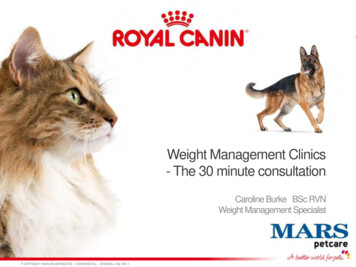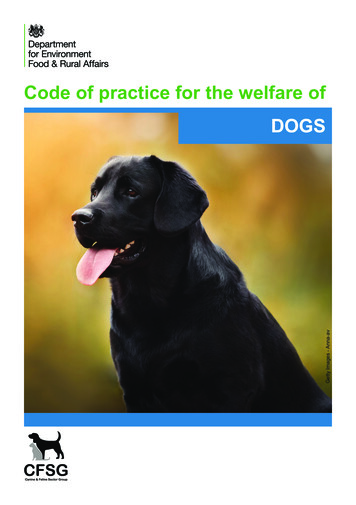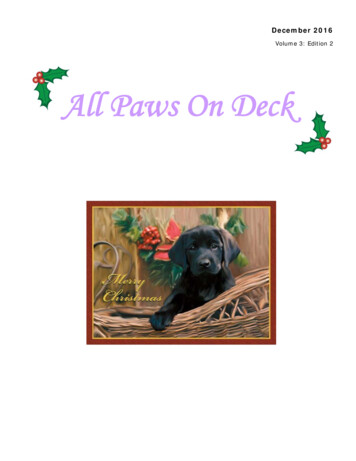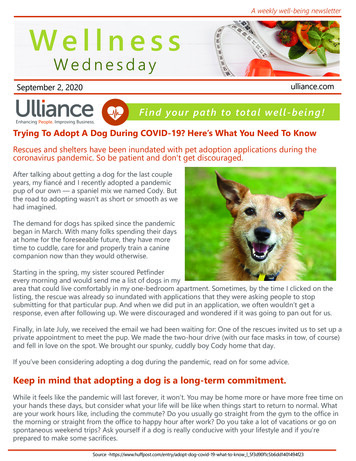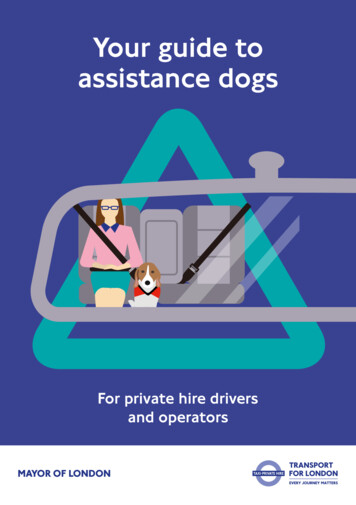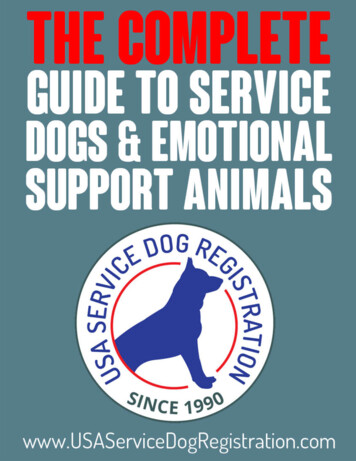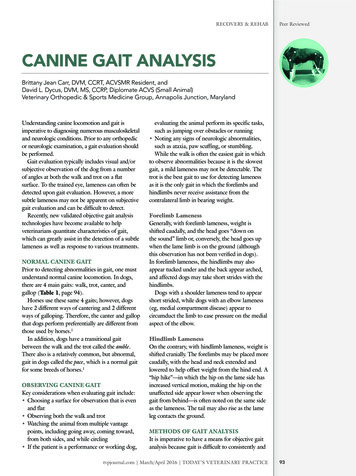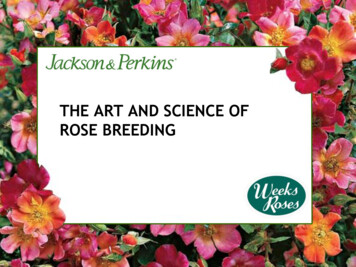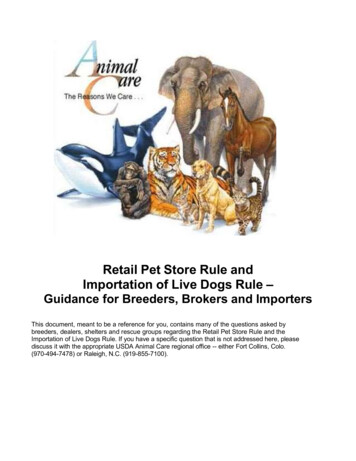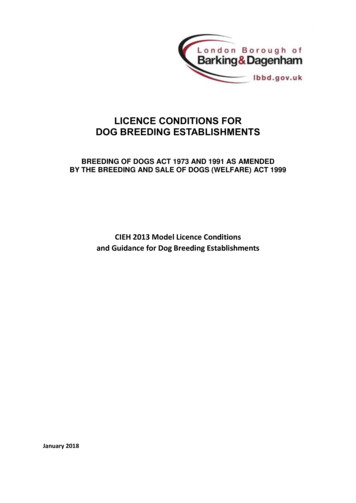
Transcription
LICENCE CONDITIONS FORDOG BREEDING ESTABLISHMENTSBREEDING OF DOGS ACT 1973 AND 1991 AS AMENDEDBY THE BREEDING AND SALE OF DOGS (WELFARE) ACT 1999CIEH 2013 Model Licence Conditionsand Guidance for Dog Breeding EstablishmentsJanuary 2018
IntroductionThe 1973 Breeding of Dogs Act (‘the 1973 Act’) requires proprietors of breedingestablishments to be licensed. Under the authority of the 1973 Act, local authorities mayissue licences to proprietors of breeding establishments stipulating conditions which must becomplied with by the licensee.CIEH 2013 Model Licence Conditions form the recommended basic minimum standardsconsidered necessary to ensure the health, safety and welfare of animals at dog breedingestablishment. Having regard to the Animal Welfare Act 2006 and changes in animal welfare.Unless otherwise stated, these conditions shall apply to all buildings and areas to which dogshave access and/or used in association with the breeding of dogs.This guidance is aimed at all those who are tasked with inspecting, advising and licensingkennels under the Breeding of Dogs Acts 1973 and 1991 and Breeding and Sale of Dogs(Welfare) Act 1999. It may also be useful to owners and managers of kennels and thoseplanning to build breeding kennels who wish to better understand what their legalrequirements are under the 1973 Act the 1991 Act and the Animal Welfare Act 2006 (‘the2006 Act’) as well as other related legislation, and how to improve compliance with the licenceconditions.Licence DisplayThe principal legislation dealing with Dog Breeding Establishments is the Breeding of Dogs Act1973 and 1991, and the Breeding and Sale of Dogs (Welfare) Act 1999, which addresses theareas covered by the licence relating to animal welfare and management.It is essential that owners and those responsible for premises management are aware of thelicence conditions.A copy of the licence and its conditions must be displayed to the public in aprominent position in, on or about the boarding establishment.Page 1 of 51
MODEL CONDITIONS1. ACCOMMODATIONThe following definitions are provided for the purposes of inspection:Kennel - this is a physical structure and area that consists of an indoor sleeping area andoutdoor runRun - A run is defined as an area attached to and with direct and permanent access from akennel.Outdoor exercise area - a separate area from the kennel itself where dogs may, for example,exercise, play, interact with other dogs and peopleCrate - a safe, secure area that a dog can go into for short periods of time. Usually consists ofa wire frame with a removable tray in the base for bedding, but can also be plastic, or fabric.Uses include security, transportation or following veterinary advice. NB: This should only bea temporary enclosure for a dog and only where the dog is habituated to it.1. General1.1 ConditionDogs must at all times be kept in accommodation suitable as respects construction, size ofquarters, numbers of occupants, exercising facilities, temperature, lighting, ventilation andcleanliness [Breeding and Sale of Dogs Act 1973 S.1 (4) (a)].1.2 ConditionDogs kept in domestic premises must have free access to more than one room and every dogmust be provided with continual access to a comfortable, dry, draught-free, clean and quietplace to rest.1.3 ConditionDog crates, where used (and whilst not acceptable as permanent housing) must be ofsufficient size to allow each dog to be able to sit and stand at full height, step forward, turnaround, stretch and lie down in a natural position and wag its tail without touching the sidesof the crate and to lie down without touching another individual.GuidanceBitches with litters should be given extra space.2. Kennel Construction2.1 ConditionWhere kennels are provided, within converted outbuildings, consideration must be given tocleaning, wildlife access, vermin control, natural lighting and ventilationPage 2 of 51
GuidanceIn new constructions, wood should not be used on exposed surfaces of walls, floors,partitions, door frames or doors in the dog kennelling area.Existing buildings may be more expensive to adapt and less efficient to operate than newbuild kennels. Proposed building works may require approval from the building controldepartment and/or planning department.Where wood has been used in an existing construction it must be smooth and treated torender it impervious. The purpose of avoiding wood on surface structures of kennel interiorsis because of the possibility of damage to the material caused by scratching or chewing bydogs. Worn and splintered material is difficult to clean, harbours bacteria, viruses and so on,and allows the splinters to penetrate the animal’s skin.2.2 ConditionAll internal surfaces used in the construction of walls, floors, ceilings, partitions, doors anddoor frames must be durable, smooth and impervious, easily cleaned and disinfected. Kennelsmust be free from hazards and there must be no projections or rough edges liable to causeinjury.Sleeping areas of kennels must be insulated so as to prevent extremes of temperature.GuidanceAll exterior wood should be properly treated against wood rot, e.g. tanalised. Only non-toxicproducts should be used.The interior and exterior of the buildings should be kept in good decorative order and repair.Outer paths, gardens, exercise areas and general surroundings should be kept in good, clean,safe condition.3. Security3.1 ConditionThe construction must be such that the security of the dog is ensured.Fencing material must be safe and secure.GuidanceWhere galvanised welded mesh is used for fencing and cages or kennels, the wire diameter should notbe less than 2mm (14 standard wire gauge) excluding any covering and the mesh size should notexceed 5cm (2in).4. Walls and Partitions4.1 ConditionWalls with which dogs may come into contact must be of smooth impervious materials,capable of being easily cleaned and disinfected.Page 3 of 51
GuidanceWhere concrete or other building blocks or bricks are used, they should be sealed so as to besmooth and impervious, and resealed as necessary.Junctions between vertical and horizontal sections should be coved. If impractical in existingpremises, all joints should be sealed.It is suggested that partition walls between kennels and individual exercise areas should beof solid construction and of sufficient height to prevent direct nose-to-nose contact betweendogs.Partition construction may be solid from floor to ceiling, but this should not be to thedetriment of other welfare considerations such as the dog’s outlook, lighting, ventilation.Suitable materials for the construction of partition walls include properly surfaced imperviousbrick/block constructions, moulded plastic, glass reinforced plastic (GRP) and pre-formedplastic surfaced board.Constructing a solid partition provides a physical barrier to infection.5. Floors5.1 ConditionFlooring must be of a non-slip, urine-resistant material. It must be laid in a way and at a fallthat avoids the pooling of liquids. Slatted or wire mesh floors must not be used.GuidanceIt is recommended that new kennels should incorporate a damp proof membrane.All floors of kennels and individual exercise areas should be constructed and maintained insuch a condition as to prevent pooling of liquids.5.2 ConditionFloors of all buildings, individual exercise areas and kennels must be of smooth, imperviousmaterials, capable of being easily cleaned and disinfected while providing sufficient grip forthe animal to walk or run without sustaining injury.GuidanceIn new constructions, it is recommended that floors should be laid to a minimum fall of 1 in80 leading to a shallow drainage channel or effectively covered deep drainage channel.Communal exercise areas should also be suitably drained to prevent pooling of liquids.6. Ceilings6.1 ConditionCeilings must be capable of being cleaned and disinfected.Page 4 of 51
7. Doors7.1 ConditionKennel doors must be strong enough to resist impact and scratching and must be capable ofbeing effectively secured.GuidanceWhere metal bars and frames are used, they should be of suitable gauge with spacingadequate to prevent dogs and puppies escaping or becoming entrapped.Where metal edging is used, this should not present a risk of injury to the dog.Door openings should be constructed such that the passage of water/waste is not impeded,or allowed to accumulate due to inaccessibility.When designing kennel doors, regard should be had to the health and safety of the personworking in the kennel, for example, large dogs may push against the door which may give riseto difficulties in securing the door and even to accidents to the person on the opposite sideof the door when it opens outwards. A door which opens inwards may also reduce thepossibility of escape.8. Windows8.1 ConditionWindows must not pose a security risk and must be escape proof for the protection of thedog as well as the public.GuidanceWhen windows are so situated that they could pose a security risk, it is recommended thatwelded mesh or reinforced glass, polycarbonate or other impact resistant material is used.9. Drainage9.1 ConditionThe establishment must be connected to mains drainage or an approved sewerage disposalsystem.GuidanceDrainage channels should be provided near to the kennel edge so that urine cannot pass overwalk areas in corridors and communal access areas. A separate drainage channel may beneeded in the exercise area. Advice concerning waste water outlets should be sought fromthe Environment Agency and/or, the local authority.10. Lighting10.1 ConditionDuring daylight hours light must be provided to exercise and sleeping areas so that all partsare clearly visible.GuidanceWhere practicable this should be natural light.Page 5 of 51
10.2 ConditionLighting must be of sufficient standard to enable efficient working both during and afterdaylight hours.Supplementary lighting, adequate to allow inspection, must be provided throughout theestablishment.GuidanceIt is recommended that breeding establishments should have a low level night light for useafter daylight hours.11. Ventilation11.1 ConditionVentilation must be provided to all interior areas without the creation of excessive, localiseddraughts in the sleeping area.GuidanceA balance should be struck between providing adequate ventilation while avoidingunnecessary loss of heat. Checks need to be made during the day and night to allow fortemperature fluctuations. Ventilation is important in disease control. It provides protectionagainst accumulation of odour and prevents excessive humidity. High humidity increases therisk of infectious bronchitis (‘Kennel Cough’).12. Kennel Design (Size, layout and exercise facilities)12.1 ConditionKennels must be divided into sleeping and activity areas.Kennels must be provided with an adequate size of sleeping area, such that dogs can stand,turn around, stretch and lie down flat in a natural position, with sufficient space for the doorto open fully.GuidanceSpecial consideration should be given to whelping bitches and bitches in season. Kennelsshould cater for the maximum number of puppies having regard to the size of the breed andlitter size. (See also Appendix D).When constructing kennels, an appropriate design and correct materials should be used toovercome problems of noise emission and to ensure energy conservation. This is in order tominimise discomfort to the dog and risk of nuisance to persons in the vicinity of the site.All parts of the kennel should be easily accessible to undertake thorough cleaning by staff.12.2 ConditionAdequate exercise areas must be provided for all kennels. Dogs must be able to walk, turnaround easily, wag their tails without touching the kennel sides, and lie down withouttouching another dog.Page 6 of 51
Kennels and runs must open onto secure corridors or other secure areas so that dogs are notable to escape from the premises.Exercise areas must not be used as sleeping areas.Outdoor areas where animals exercise and interact cannot have strict temperatureregulation. Dogs must not be restricted to such areas when climatic conditions may causethem distress. They must have constant access to fresh clean water, shade and shelter so theycan avoid rain, wind, snow, ice or direct sunlight, etc.In adverse weather conditions, the responsible person must decide whether or not dogs aregiven free access to their run.The run must be at least partially roofed to provide the dog with sufficient protection againstall weathers.GuidanceDepending upon the breed, consideration should be given to covering the whole of the runs.13. Beds and Bedding13.1 ConditionThe bed must have clean bedding and be large enough for each dog to lie flat on their side.Beds must be suitable to allow dogs to be comfortable, i.e. of durable construction, be sitedaway from and offer protection from draughts and be of a suitable size for the size and typeof dogs kept.Bedding must be capable of being easily cleaned and disinfected.GuidanceAll bedding material in use should be clean, non-irritant, parasite free and dry.Chewing or destruction of bedding should not result in restricted access, rather alternativematerials should be tried.14. Number of Dogs Permitted14.1 ConditionThe maximum number of dogs to be kept at any one time is to be determined by the LocalAuthority (see also Appendix D).The number of dogs permitted must relate to the number and size of the kennels or spaceavailable and will be stipulated clearly on the front sheet of the licence. The decisionregarding the number of dogs permitted to be kept must take into account the maximumlikely litter size as well as the effectiveness of site management.GuidanceThe figure should include any dogs kept on the breeders’ premises which are not being usedfor breeding and must not be exceededPage 7 of 51
15. Temperature in Accommodation15.1 ConditionHeating facilities must be available in the kennel and used according to the requirements ofthe individual dog.GuidanceThere should be some part of the sleeping area where the dog is able to enjoy a temperatureof between 10 C - 26 C. Temperature should be relevant to the type and breed of dog. Ifnecessary, heating and/ or automatic cooling/ventilation should be used to achieve this.The materials used on the kennel exterior should offer adequate protection againsttemperature variations throughout the year. The difficulty of maintaining the idealtemperature is acknowledged; however, these are realistic temperatures and should not beexceeded in normal circumstances.15.2 ConditionDevices used for heating and cooling must be safe and free from risk of burning orelectrocution. Manufacturer’s instructions must be followed. Open flame appliances must notbe used. (See Health and Safety at Work Act 1974 under Other Relevant Legislation).GuidanceThere should be the ability to record temperatures at dog level. (See also Record Keeping atSection 6 – Health and Welfare of the Breeding Stock and Litters).There will be periods in the year where ambient external temperatures will causetemperatures to fluctuate above or below the recommended levels. If the higher temperaturelevel is exceeded due to structural shortcomings rather than normal ambient temperature,then artificial means of counteracting this high temperature should be introduced.Where temperatures fall below the recommended level, the use of individual heating lampsfor dogs may prove adequate. In some circumstances additional background heating will alsobe required.Failure to give adequate attention to construction and insulation may cause dogs to sufferand increase running costs. Geographical orientation will affect temperature, e.g. north facingopenings make it difficult to maintain adequate heating levels. Correct orientation of thekennel will allow maximum use of natural light.16. Cleanliness(See also Appendix E – Cleaning Standard Operating Procedure (SOP))16.1 ConditionAll kennels, corridors, common areas, kitchens and so on must be kept clean and free fromaccumulations of dirt and dust so that disease control is maintained. Each occupied kennelmust be cleaned daily at a minimum. An agreed SOP must be followed.Each occupied kennel must be cleaned daily at a minimum.Page 8 of 51
GuidanceRegular disinfection should be demonstrated by keeping records of disinfecting regimes.(See also SOP – Appendix E).16.2 ConditionAll excreta and soiled material must be removed from all areas used by the dogs as necessary.All sleeping areas and bedding must be kept clean and dry.Facilities must be provided for the proper reception, storage and disposal of waste.GuidanceAdvice should be sought from the Environment Agency or local authority concerning removalof waste such as dog faeces, soiled material and infectious material.16.3 ConditionMeasures must be taken to minimise the risks from rodents, insects and other pests withinthe breeding establishment.GuidanceSuch pests should be adequately dealt with without delay to eradicate the infestation.16.4 ConditionFoul waste water must be disposed of by discharge to the appropriate or an approveddrainage system. Those wishing to operate an incinerator must seek advice from theEnvironment Agency and/or the local authority. (See Environmental Protection under Other RelevantLegislation).GuidanceThere is a range of cleaning regimes. The regime should include:1. Removal of solids2. Washing3. Disinfection4. DryingThe physical collection of faeces is usual (‘poop scoop’ or shovel and bucket). The use ofdetergent and water will ‘wash down’. Pressure hoses or steam cleaning will wash down moreeffectively. Bacteria, viruses, fungi need to be controlled by the sanitising process. Becausedisinfectant is washed away after a short period of time, the long term activity of chemicalsused to control viruses, bacteria and fungi should be considered (see also SOP – Appendix E).Great care should be taken when using any chemicals. Chemicals and materials should beused and stored correctly. (See COSHH Regulations under Other Relevant Legislation).Combinations of bactericides, fungicides and virucides may prove expensive to use and maynot necessarily provide the best system. Professional advice should be sought for the mosteffective method.Staff working from kennel to kennel further increase the risk of spreading disease. Staff shouldbe trained in good kennel hygiene. Complete disinfection of kennel and equipment should becarried out between occupancies.Page 9 of 51
17. Whelping Facilities17.1 ConditionThere must be a separate whelping pen or room for each whelping bitch in which to whelp.There must be direct access to the whelping area for kennel personnel without disturbing thegeneral kennel population. Once separated there must be increased social contact withhumans.GuidanceBitches should be moved to their whelping accommodation 60 days after mating or sooner ifsigns of imminent whelping are shown.17.2 ConditionEach whelping pen must be constructed of easily cleanable impervious materials. The areamust be cleaned regularly and a record kept of cleaning procedures. The whelping pen musthave a divider to allow the bitch to access an area where she cannot be reached by thepuppies. There must be natural daylight.There must be a whelping bed raised off the floor and with sides high enough to prevent newborn puppies from falling out. The bed must contain sufficient bedding to ensure a softsurface for the bitch and to enable the absorption of mess resulting from whelping. The bedmust be constructed of easily cleanable impervious material and must be thoroughly cleanedand disinfected between litters.GuidanceWhere a bitch is whelped in a domestic environment it is acceptable for a temporarydisposable covering to be used.Varnishing wood will make it impervious.17.3 ConditionThe whelping area must be maintained at an appropriate temperature. The bitch must beable to move away from heat spots.GuidanceThere should be an area maintained between 26-28 degrees Celsius. This can be achievedwith a local heat source such as a heat lamp.Puppies under four weeks of age should be kept at a temperature between 26 C (79 F) to28 C (82 F) with provision for the bitch to move to a cooler area.17.4 ConditionBitches must be adequately supervised during whelping and records kept of: time of birth of each puppy puppies’ sex, colour and weight placentae passed any other significant events.Bitches must be allowed a minimum of four periods a day for toileting and exercise away fromtheir puppies.Page 10 of 51
18. Bitches in Season18.1 ConditionConsideration should be given to separating bitches in season and they must not be kept withentire male dogs.2. MANAGEMENT19. General19.1 ConditionDogs must be adequately supplied with suitable food, drink and bedding material, adequatelyexercised, and visited at suitable intervals [BDA 1973 S.1 (4) (b)].The 1999 Act strengthens the requirements for dogs to be visited at suitable intervals.The Animal Welfare Act (2006) sets out the Duty of Care which must be met by the personresponsible for the animals (see Animal Welfare Act under Other Relevant Legislation)Guidance(See also Appendix L – Daily Routine SOP)20. Supervision20.1 ConditionA fit and proper person must always be present to exercise supervision and deal withemergencies.GuidanceAny person with responsibility for supervision should be over the age of 16.Where staff are employed, ideally a written training policy should be provided. Training ofstaff, whether permanent or temporary, should be demonstrated (via appropriate trainingrecords) to have been carried out on all aspects of the care of all ages of dogs and updatedregularly. Staff should be adequately trained in the work they are expected to carry out. Forexample, in handling dogs safely and in procedures to be followed in the event of anemergency. (See Health and Safety at Work Act 1974 under Other Relevant Legislation).The following are regarded as essential topics to be covered in the training programmerelating to the care of dogs: Animal Health and Welfare; Cleanliness and Hygiene; Feeding andFood Preparation; Disease Prevention and Control; Recognition of Sick Animals; Dog Handling;Health and Safety; Emergency Procedures, Normal Whelping and Responsible Breeding.There are a variety of animal care courses available and staff should be encouraged to attendRelevant NVQs attained at Level 2 or the equivalent should enable staff to gain a minimumlevel of competency.Page 11 of 51
21. Numbers of staff21.1 ConditionNumbers of staff must be appropriate for the breed/ type and number of dogs being bred.Numbers must be sufficient to provide the level of care set out in these model conditions.GuidanceStaff numbers should be of concern when there is evidence that the standards maintainedor the condition and behaviour of the animals is being compromised, or where an unrealisticroutine is in place.21.2 ConditionSufficient adequately trained staff must be available every day to carry out all the interactionsand procedures with dogs specified in this document.21.3 ConditionEstablishing the number of staff required will require an assessment of the conditions at theestablishment. As a guideline, it may be considered that a full-time attendant may care for upto 20 dogs. In domestic environments, it is advisable for other members of the household, ordog sitters to be provided with guidance notes in regard to general day to day care – feeding,grooming, cleaning, exercise and compatibility issues – especially where several dogs, orbreeds of dogs, are involved.21.4 ConditionDogs must not be left alone for long periods and must be checked at the start and end ofevery working day and regularly by a member of staff at least every four hours during the day.GuidanceThese checks should be more frequent when bitches are imminently due to whelp, whelpingand puppies that are not yet weaned (See also Section 2 – Management and Section 6 –Health and Welfare of the Breeding Stock and Litters). Condition22. Environmental Enrichment and Exercise22.1 ConditionDogs must be provided with environmental enrichment and the ability to have some controlover their environment.GuidanceToy and activity feeders that are changed regularly are ideal enrichment. There should bemore toys or feeders than there are dogs in the kennel. The use of raised beds and the abilityto move out of other dogs’ sight should be provided (see also Puppy Plan Annex B).22.2 ConditionBreeding establishments are the permanent home for some dogs and therefore provision ofexercise facilities must be adequate for the long term. Dogs must not be kept permanentlyconfined.Arrangements must be made for the dogs to be exercised at least twice a day.Page 12 of 51
GuidanceExercise may also be provided by walking. Where dogs are exercised off the premises,reference should be made to the Clean Neighbourhoods Environment Act (2005) and theControl of Dogs Order 1992 (see Other Relevant Legislation). The name, address andtelephone number (including the emergency number) of the establishment’s veterinarypractice should be displayed prominently preferably by the telephone.23. Handling and Habituation23.1 ConditionBreeding dogs must be handled and examined regularly to identify changes in health, weightand behaviour, also to ensure dogs are habituated to handling by people. This is particularlyimportant for bitches, as fear of people will influence development of puppy behaviour.GuidanceAn SOP for the socialisation and habituation of puppies from birth to the point of sale shouldbe used (see Puppy Plan Annex B and Annexes F & G on Socialisation and Habituation).24. Food and Water Supplies24.1 ConditionAll dogs must be adequately supplied with suitable food. Clean water must be available at alltimes and changed at least daily. Dogs must be fed a diet appropriate to their age, breed,activity level and stage in the breeding cycle. Dogs must be fed individually with separatebowls. Food must be stored in vermin-proof containers and fresh food must be refrigerated.GuidanceThe dogs’ weight should be monitored and recorded quarterly and diets adjusted wherenecessary, unless otherwise advised by a veterinary surgeon or a significant change in thedog’s weight/body condition is noticed.24.2 ConditionEating and drinking vessels must be capable of being easily cleansed and disinfected toprevent cross contamination. They must be maintained in a clean condition and cleaned anddisinfected or disposed of after each meal.GuidanceIf necessary, the veterinary surgeon should be consulted to advise. Special dietaryconsiderations should be given to young and old dogs and to whelping and nursing bitches.Nutrition is particularly important during pregnancy and lactation and consideration shouldbe given to the varying nutritional requirements of individual dogs. Body condition scoreshould be monitored and feeding adjusted appropriately. (See also Annex H – Feeding SOP).24.3 ConditionDogs must be fed sufficiently well to maintain health.GuidanceInspectors should observe the general condition of the dogs and check on the quantity of foodin store and the process of preparation.Page 13 of 51
25. Weaning Procedures25.1 ConditionPuppies must start the weaning process as soon as they are capable of ingesting food on theirown. The food offered must be appropriate for the stage of development of the puppies.Puppies at weaning must initially be offered food five times a day. It must be ensured thateach puppy takes the correct share of the food offered.GuidanceWeaning should normally commence at 3-4 weeks old. The initial diet may be liquidprogressing to solid food over the ensuing period.25.2 ConditionDuring lactation, the bitch must have sufficient appropriate food to satisfy the demands beingmade upon her.GuidanceLactation will last until the puppies are weaned. Consideration should also be given to howmany puppies the bitch is nursing. During lactation the bitch should be closely monitored forsigns of complications (e.g. eclampsia). The feeding level required for the bitch after weaningwill depend upon her body condition.Where a proprietary food source is used the manufacturer’s guide should be followed.Veterinary advice should be sought if in doubt.Food provision can be used to enhance enrichment, for example through the use of devicesincreasing the time and effort taken to access food (e.g. puzzle feeders, activity balls, stuffedrubber toys). Where these are used they should be cleaned and disinfected thoroughlybetween each use. Where dogs are kept in pairs or larger groups, more devices should beavailable than the number of dogs, use should be monitored carefully to identify whereaggression occurs. Dogs which show aggression associated with feeding, or when providedwith food based enrichment, should be separated from other dogs prior to feeding.26. Kitchen Facilities26.1 ConditionFacilities, hygienically constructed and maintained, must be provided for the storage andpreparation of food for the dogs.Where fresh and cooked meats are stored, refrigeration facilities must be provided. Foodcontamination must be avoided.A sink with hot and cold running water must be available for washing kitchen utensils andeating and drinking vessels.GuidanceA separate hand basin with hot and cold running water should be provided for staff.Page 14 of 51
26.2 ConditionContainers for storing foods must be provided and must be constructed and maintained toguard against insects and other pests.Cross-contamination must be avoided.GuidanceDishes and bedding should be washed separately from domestic items.27. First-Aid Kit for Dogs27.1 ConditionA fully maintained first-aid kit suitable for use on dogs and puppies must be available andaccessible on the premises.GuidanceA veterinary surgeon should be consulted concerning its contents and a competent memberof staff should be in charge of its maintenance.28. Is
Dogs must at all times be kept in accommodation suitable as respects construction, size of quarters, numbers of occupants, exercising facilities, temperature, lighting, ventilation and cleanliness [Breeding and Sale of Dogs Act 1973 S.1 (4) (a)]. 1.2 Condition Dogs kept in domestic premises must have free access to more than one room and every dog
